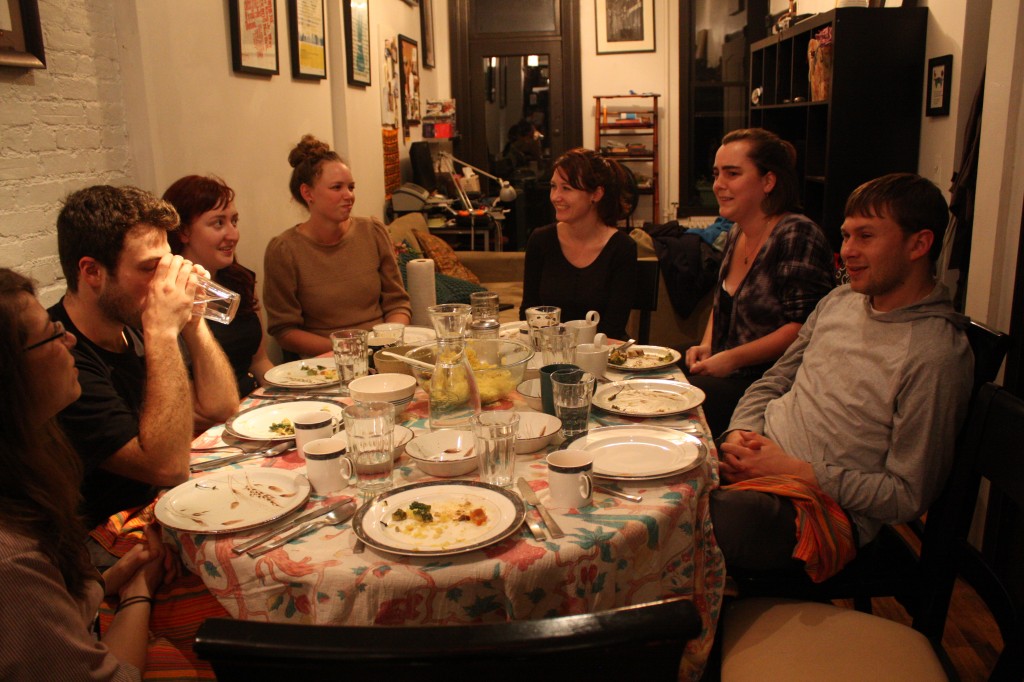It's apparently well-known across the Subcontinent that Bengalis take their cooking and eating very seriously. In fact, most Indian restaurants you have eaten at were probably actually run by Bangladeshis. (At the risk of greatly over-simplifying, Bengali refers to both a language and a culture, whose homeland after the partition of 1947 upon Britain's departure was split into the mostly Hindu state of India of West Bengal whose capital is Kolkata; the mostly Muslim eastern portion of Pakistan, which gained independence in 1971, is now called Bangladesh.) Bangladesh is the world's eighth most populated country at around 145 million, and ninth most densely populated, with 2,559 people per square mile. That's almost 31 times more dense than the US.
Straddling the delta of of the great Ganges-Brahmaputra river system, Bangladesh's food features fish and rice as staples. But since several of our vegetarian friends hadn't been able to fully enjoy a Noshes dinner so far, we decided to take advantage of the ample flesh-free options of Bangladeshi cuisine. So at the Bangla Nagar Grocery in Kensington, Brooklyn, which accepts Bangladeshi taka, I steered away from the fish and meat counter, and instead delved whole-heartedly into the vegetable section full of bizarre-looking specimens. I also made sure to try a fish dish at the restaurant next door, which was delicately flavored, moderately spicy, and riddled with seriously dangerous bones.
Our vegetarian contingent tonight featured two classmates from high school I'd not seen in ten years: standup comedian Emily Heller and her friend Sam, as well as Michelle, Zach, Christen, Sean and Sophie. We all diligently ate the meal, most of which was seasoned with judicious dabs of pungent mustard oil and smatterings of the panch phoron (five-spice blend), with our hands.
Cha | Tea
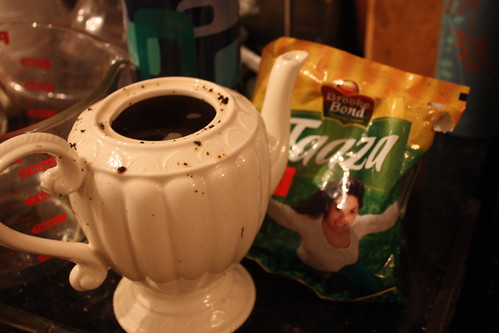
Rudina, two-time Nosher, just happened to go to Bangladesh recently, so I asked her how they take their tea. Turns out it's milky and very sweet. So that's how we had it, made with loose Bangladeshi tea that I randomly pulled from the shelf. It was tasty and the caffeine is still powering me, a few hours later.
Shokto | Vegetable simmer | Recipe (I added pumpkin as suggested elsewhere)
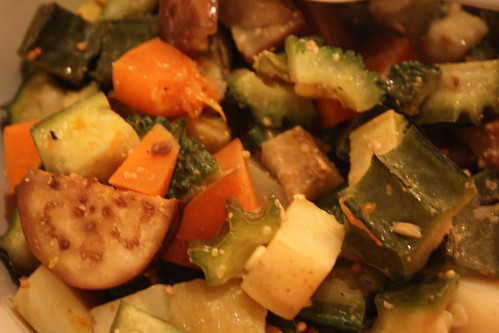
Apparently there's a common saying that you shouldn't eat shokto at night, but nobody knows why. But this dish seemed so important to Bangladeshi cuisine, and also big on vegetables and meat-free, so we went for it. It also was an opportunity to use those funny veggies, like bitter melon, ridged gourd, and green cooking banana. Whew, pretty intense! It was our first encounter with the mustard oil that graced pretty much every dish. Some of the veggies were nice, like the pumpkin, but the bitter melon was too accurately named even for my adventurous taste.
Pulao | Bengali pilaf | Recipe

It was perhaps a bit too much water, but gosh it was tasty. With a little pre-saute of raisins and spices, chilies for a little zing, turmeric for a bold color, and a sprinkling of sugar, this was a nice counterbalance to the heady vegetables. This plus the shokto constituted the first course.
Masoor dal | Red lentil stew | Recipe
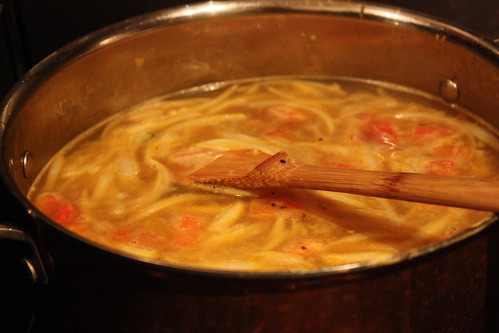
Again with too much water, but this dal had a lot more flavor than most I've tasted. (A little too much for some, it was kinda spicy.) Despite the common advice to eat with fingers, we couldn't figure out how to do it with this soupy bowl, so we cheated with spoons. I forgot the lime juice, that would have been nice to zing it up a bit.
Alu posto | Potatoes with poppy-seed paste | Recipe

Poppy seeds are a distinctive part of Bengali cuisine, and alu posto is the dish par excellence to show it off. With just a bit of chili powder and mustard oil, this was a relatively simply spiced dish that paired nicely with the more complex dal. Interestingly, the poppies of Bangladeshi food are 95% white, rather than the 100% black ones we get here.
Tomato chatni | Recipe

A chutney is a sweet, almost jam-like goop that keeps forever in the back of the fridge, right? Well, not to Bengalis. It's a lightly sweetened, freshly made course that goes between the main meal and dessert, as a kind of palate-cleanser. As if to highlight the crossover nature of this course, one of the classic Bengali chatnis is made with tomatoes. The mustard oil and spices keep one foot in the savory side, the palm jaggery (a distinctly-flavored compressed sugary thing) sweetens it up, and the tomato flirts heavily with both sides, as befits a fruit that most often acts like a vegetable.
Kancha aamer chatni | Green mango chatni | Recipe
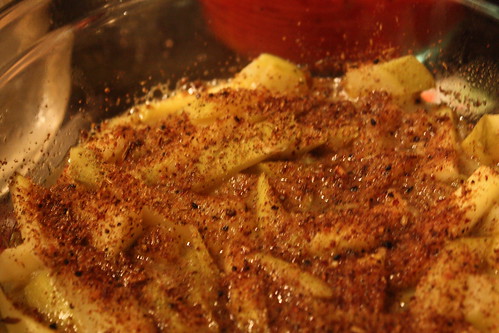
I was only planning to make the tomato chatni, but when I saw the green mangoes at the market, I had to get them. (I also got a green papaya that I hope to do something with this week.) This works for the same reason as the tomato chatni, but in the opposite direction: normally rich and sweet, this fruit acts like a tart veggie when under-ripe. On top is a dusting of toasted and ground panch phoran spices.
Rasgulla | Fresh cheese balls in syrup | Recipe
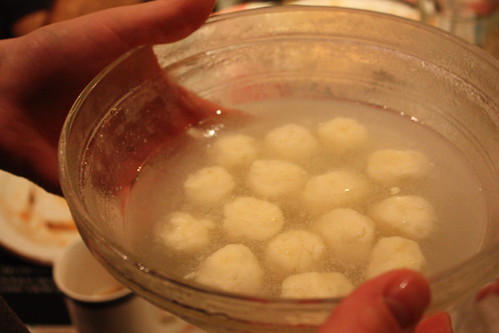
It blows my mind a bit that it's so easy to make cheese, at least the very basic versions. Boil milk, add citric acid, drain the whey, squeeze it through cheesecloth, and boom, you've got your curds. In this case, one liter of milk yielded sixteen little balls, which I then boiled in clarified sugar water until they puffed up. Imagine if feta cheese were sweet instead of salty, packed in syrup instead of brine. If that sounds good to you, then you'd like this.
Guided by Sean's excellently curated playlists of Bangladeshi DJs and pop music, we then cracked into some store-made sweets that were all variations on the theme of taking dense dough and dousing it in sugar water. Density surrounded and at times inundated by water: cuisine mirrors geography.
We're taking off again next week, and will be returning to the Caribbean with a meal from Barbados on the 20th.
